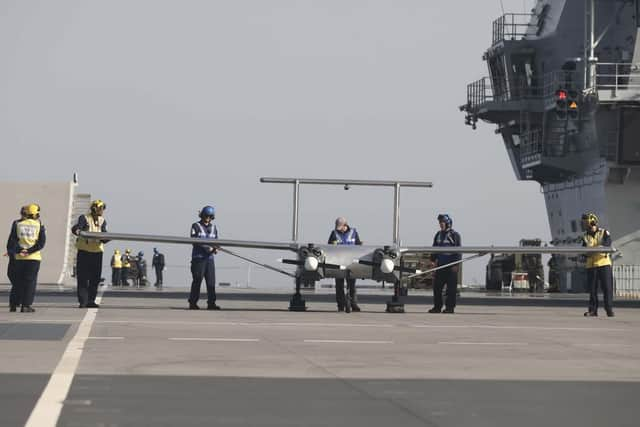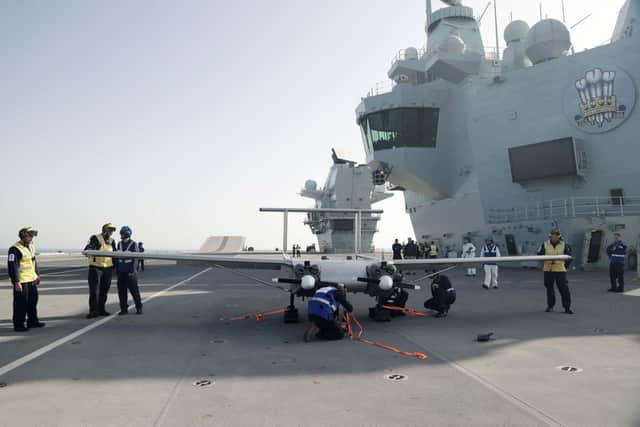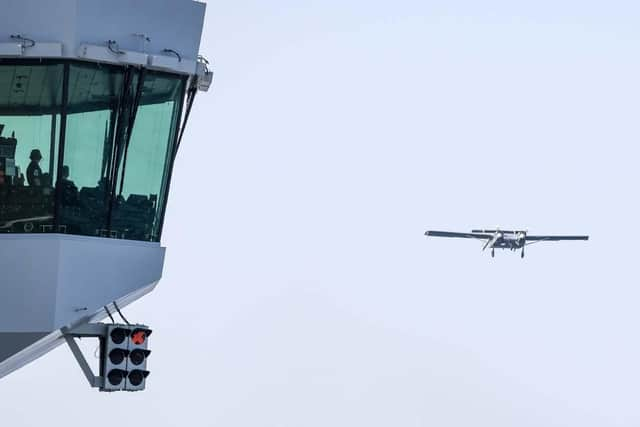HMS Prince of Wales: History made as pilotless plane takes off and lands on Royal Navy ship for first time
and live on Freeview channel 276
The W Autonomous Systems (WAS) drone did a supply drop for HMS Prince of Wales. It flew from the Lizard Peninsula and on to the deck of the huge aircraft carrier – which weighs 65,000 tonnes – and back again.
Supplies were delivered as part of the mission off the Cornish coast. Captain Richard Hewitt, Commanding Officer HMS Prince of Wales said: “HMS Prince of Wales is a fifth-generation aircraft carrier and operating autonomous drones like this will become the norm across future Royal Navy Carrier Strike Groups in our 50-year lifespan.


Advertisement
Hide AdAdvertisement
Hide Ad“We are all proud here in HMS Prince of Wales to achieve this – a fantastic milestone for all involved and the first of many firsts on this deployment to shape the future of Royal Naval Carrier Strike innovation as we prepare for our strike group deployment in 2025.”
The Royal Navy are testing whether crewless aircraft can be operated safely, and if they can be deployed alongside F-35 Lightning jets and naval Merlin and Wildcat helicopters.
The goal is to deploy drones with a UK Carrier Strike Group to transfer stores and supplies – such as mail or spare parts – between ships without the need to launch helicopters. Using drones can eliminate the risk to any potential aircrew travelling in bad weather and other dangerous situations.
They are also cheaper to operate and allows for helicopters to freed up for other operational missions such as hunting hostile submarines or surface vessels which are threats to the carrier strike group. HMS Prince of Wales has experimented with drone technology before


Advertisement
Hide AdAdvertisement
Hide AdSmall quadcopters and Banshee targets – small jets which are launched by catapult and parachutes down to land when a mission is complete – where tested aboard the vessel. The drones incorporate a ground-breaking autopilot system, eliminating the need to be controlled remotely by trained pilots.
Its HCMC twin-engine light alloy twin boom aircraft is capable of carrying a payload of 100kg for up to 620 miles. The drones can also land on uneven ground and needs a runway of just 150 metres to take off and land.
This is a little over half the length of the flight decks on the UK’s Queen Elizabeth-class aircraft carriers. Lieutenant Ash Loftus, leading the trials for the Royal Navy on board HMS Prince of Wales said the demonstration is a culmination of 18 months of hard work.


He added: “Carrier aviation is amongst the most difficult aspects of naval warfare and this success is testament to their efforts.” Stephen Wright, executive chairman and founder of W Autonomous Systems, said: “This landing demonstrates the agility of our autonomous drone. We are hugely proud to deliver this ground-breaking trial for the Royal Navy and showcase the future of aviation.”
Advertisement
Hide AdAdvertisement
Hide AdHMS Prince of Wales will be operating off the Eastern Seaboard of the USA until Christmas, after leaving Portsmouth on September 1. Exercises and experiments with F-35 Lightning stealth fighters, MV-Osprey tilt-rotors, and the Mojave drone will be undertaken.